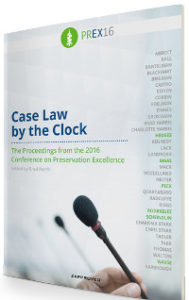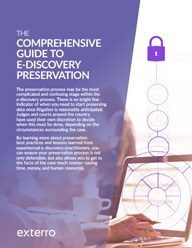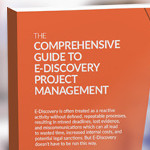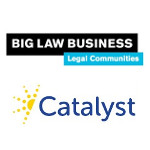Samantha Green, Esq.
Adam Bottner, Esq.
DTI

As we move into 2016, many of us will be trying to keep the New Year’s resolutions that we made. Eat less carbs, read more, be more organized, call your parents more often, cooperate with your adversaries, etc…
Hold on, “cooperate with your adversaries”? Why would anyone ever want to do that? Well, if you’re a litigator, you may need to make this one of your resolutions for 2016. In the amendments to the Federal Rules of Civil Procedure that took effect on December 1, 2015 and apply to federal cases filed after that date, there is an acknowledgement of the role of cooperation amongst parties. That being said, several questions come to mind, with the primary thought, how far does a party need to go to be deemed cooperative?
“Cooperation”, according to Webster’s, is defined as “the process of working together to the same end”. “Adversary”, by definition, is “one’s opponent in a contest, conflict, or dispute”. So how do two adversaries cooperate? Putting these terms together is oxymoronic, kind of like jumbo shrimp. However, in order to advance the goals of the Federal Rules of Civil Procedure[1], as amended (“They should be construed, administered, and employed by the court and the parties to secure the just, speedy, and inexpensive determination of every action”), adversarial cooperation is now the standard that the judicial system is demanding. So in terms of the discovery process, how can you be a cooperative attorney without being a[n] (oxy)moron?
Cooperation is not a new concept within the framework of the FRCP. When the first uniform civil procedure rules allowing discovery were adopted in the late 1930’s, “discovery” was understood as an essentially cooperative, rule-based, party-driven process, designed to exchange relevant information. The goal was to avoid gamesmanship and surprise at trial.[2] Disciplinary Rule 7-101 of the ABA Model Rules (“Representing a Client Zealously”) states that “…a lawyer does not violate this Disciplinary Rule, however, by acceding to reasonable requests of opposing counsel which do not prejudice the rights of his client.” The overriding theme of the recent amendments to the discovery rules has been to open sharing of information by all parties to a case with the aim of expediting case progress, minimizing burden and expense, and removing contentiousness as much as practicable.[3] If counsel fail in this responsibility—willfully or not—these principles of an open discovery process are undermined, coextensively inhibiting the courts’ ability to objectively resolve their clients’ disputes and the credibility of its resolution.”[4]
Although the concept of cooperation was heavily emphasized during the rule drafting sessions, the word “cooperation” was not specifically used in the amended Rule 1. The phrase “cooperate to achieve these ends” was seriously considered, but the drafters feared collateral consequences from this verbiage, such as fostering more disagreements amongst the parties and parties blaming each other when it would lend to their respective advantage. A similar attempt at adding this type of verbiage was rejected in 1978 for the same reasons.
This time, the drafters did include a Committee Note to Rule 1 that states that “the parties share the responsibility to employ the rules” in that matter, i.e. to secure the just, speedy, and inexpensive determination of every action.[5] The Note further states that “most lawyers and parties cooperate to achieve those ends” and that it is important to discourage “over-use, misuse, and abuse of procedural tools that increase cost and result in delay.”[6] However, by declining to use the word “cooperation”, there is little guidance on where strategy and cooperation merge.
Now that we know we have to “cooperate”, the question remains of how to do so, especially with little to no guidance on what “cooperation” means. Speaking of New Year’s resolutions, many litigators resolved in 2015 to use predictive coding more in 2016 (seriously). More and more courts have stamped predictive coding as an acceptable method to cull and review data, and the judicial system has recognized the benefits predictive coding has over linear review. However, predictive coding is changing the paradigm of cooperation and work product. With the increased use of predictive coding, it seems there will be more questions about how much cooperation is enough. For example, non-responsive documents, considered work product before predictive coding, are now being requested by opposing counsel under the guise of cooperation and transparency. Does the use of predictive coding now change the definition of “work product”? With the courts strongly urging attorneys to cooperate with opposing counsel in order to streamline the discovery process, what exactly does that mean for counsel? How much information needs to be shared about the technology used or the search methodology employed in order to save costs, while still protecting counsel’s legal strategy? Can sanctions be handed down for lack of cooperation in this context?
The new federal rules do not address these questions. The drafters of the amendments to the federal rules, when discussing cooperation, took their cue from The Sedona Conference, a well-respected eDiscovery think tank frequently cited by the courts, which authored “The Cooperation Proclamation”, which does speak to predictive coding. The proclamation discusses cooperation broadly and, with regard to predictive coding, it states:
“Th[is] proclamation generally encourages that parties “reach agreement on automated search methodology…[to] locate and produce the most relevant ESI”, including keeping records and comparing results while testing different search methods in an effort to agree on the most suitable methods.”
The Seventh Circuit Electronic Discovery Pilot Program, which was formed to consider what can be done to reduce the costs of electronic discovery, and the costs of discovery and litigation more generally, also speaks to cooperation.[7] Principle 1.02 of the program states, “An attorney’s zealous representation of a client is not compromised by conducting discovery in a cooperative manner” and further “the failure of counsel or the parties to litigation to cooperation facilitating and reasonably limiting discovery requests and responses raises litigation costs and contributes to the risk of sanctions.”[8]
The courts have begun to address the issue of cooperation within the predictive coding paradigm, but with mixed results. In the Biomet case[9] the Defendant employed keyword searching and predictive coding to cull the 19.5 million documents that were originally collected. The Plaintiffs asked the Defendant to identify the entire seed set used to train the algorithm so that it could better suggest additional keyword terms. The Defendant refused to identify the seed set, representing only that all discoverable documents used to train the algorithm had already been disclosed. The Court decided that irrelevant documents used to train the system are not discoverable and the Defendant is not required to disclose these documents. However, the Court found Defendant’s refusal to cooperate troubling and urged Defendant to rethink its refusal.
Most litigators do not want to turn over non-relevant documents, but they also do not want to run afoul of the court. So, the Biomet decision creates a conundrum for counsel—it seems to be saying that the party using predictive coding does not need to turn over non-responsive documents used to train the system, but that party will then be looked upon as being uncooperative.
In Progressive Cas. Ins. Co v. Delaney, the parties “cooperatively” came together and jointly stipulated to an ESI protocol where predictive coding was not mentioned[10]. After signing the stipulation, the Plaintiff collected 1.8 million documents and applied search terms, but it only reduced the potentially responsive population to 565,000 documents. After the start of review, Plaintiff’s counsel found manual review to be too time consuming and costly so it engaged in predictive coding without consulting the Court or the Defendant. The Court said that where there has been no cooperation and little transparency in drafting a predictive coding methodology, it is reluctant to deviate from the protocol already negotiated and agreed upon. The Court required the Plaintiff to produce all 565,000 documents without review, with a clawback provision for produced privileged documents and permitted the Plaintiff to apply privilege filters to identify and withhold documents most likely to be privileged.
So, courts seem to be accepting of the use of predictive coding, especially when the parties jointly agree to an ESI protocol beforehand. However, as the Progressive case warns, one party’s unilateral deviation from the agreed upon protocol may be perceived as uncooperative. Best practice would be to always get agreement before proceeding with predictive coding.
An interesting twist to the question of cooperation in the use of predictive coding came in the Kleen Products case[11]. The Defendants used a Boolean search method, iteratively testing and refining search terms to be used, using sampling to measure the results, and validating to ensure accuracy. Almost a year after discovery began, Plaintiffs criticized specific details of Defendants’ methodologies, further arguing that “key word searching” is inherently inadequate, outdated, and flawed. Plaintiffs asked the district court to require the use predictive coding (“content-based advanced analytics”), which would have essentially required Defendants to completely start over. Emphasizing Sedona Principle 6[12], the court urged the parties to work cooperatively to consider whether the Defendants’ search methodology might be refined to satisfy Plaintiffs without disregarding all of Defendant’s work. The parties continued to meet-and-confer and, almost five months after the hearings, they reached an agreement regarding search methodology for the first phase of discovery.
So, as litigators, let’s all follow through on our common resolution for 2016 to make a sincere effort to cooperate in discovery with our opposing counsel (for those of you who did not make such a resolution, you may want to get on that). What “cooperation” means specifically in the predictive coding context has not been answered conclusively, but transparency should be paramount (as long as it doesn’t compromise strategy). While we’re at it, let’s all follow through on our resolutions to eat less carbs, read more, be more organized, and call our parents more often.
About the Authors
Samantha Green is an eDiscovery consultant for DTI. She has advised, written and spoken on all phases of the electronically stored information (ESI) life cycle. She has worked on many government investigations, second requests and litigation crossing all spectrums. Prior to DTI, Samantha was eDiscovery Attorney for Blank Rome LLP.
Adam Bottner is an attorney and director of business development for DTI. Bottner works with clients to scope and implement workflow solutions for a wide range of eDiscovery projects, including SEC and DOJ investigations and complex civil litigation matters. Bottner is a frequent author and speaker at continuing legal education programs, including programs relating to eDiscovery management and litigation readiness. Bottner chairs the Chicago Bar Association’s Cyber Law & Data Privacy Committee and is also an adjunct professor at IIT Chicago-Kent College of Law, where he is currently teaching an electronic discovery class- eDiscovery 495.
About DTI
DTI is a legal process outsourcing (LPO) company serving law firms and corporations around the globe.
[1] Federal Rules of Civil Procedure Rule 1.
[2] The Sedona Conference® Cooperation Proclamation at page 5.
[3] Board of Regents of University of Nebraska v BASF Corp. No. 4:04-CV-3356, 2007WL 3342423, at *5 (D. Neb. Nov. 5, 2007).
[4] Id.
[5] Attachment to Memorandum from John D. Bates, Sec’y, Judicial Conference of the U.S., to Hon. John G. Roberts, Chief Justice U.S. Supreme Court (Sept. 26, 2014).
[6] Id.
[7] Seventh Circuit Electronic Discovery Pilot Program, page 7.
[8] Principle 1.02 of the Seventh Circuit Electronic Discovery Pilot Program.
[9] In re: Biomet M2a Magnum Hip Implant Products Liability Litigation, 2013 WL 1729682 (N.D. Ind. Aug. 21, 2013).
[10] Progressive Cas. Ins. Co v. Delaney, 2014 WL 2112927 (D. Nev. May 20, 2014).
[11] Kleen Products LLC, et al. v. Packaging Corporation of America, et al., 2012 WL 4498465 (N.D. Illinois, Sept. 28, 2012).
[12] Responding parties are best situated to evaluate the procedures, methodologies, and technologies appropriate for preserving and producing their own electronically stored information.



 kCura offers a close look at key concepts behind processing — a technical but critical aspect of any e-discovery project. The article, written by
kCura offers a close look at key concepts behind processing — a technical but critical aspect of any e-discovery project. The article, written by  Exterro
Exterro Bloomberg BNA’s Big Law Business, in partnership with Catalyst, will present a complimentary live event, “
Bloomberg BNA’s Big Law Business, in partnership with Catalyst, will present a complimentary live event, “ Zapproved has published its updated
Zapproved has published its updated  Exterro has published a new
Exterro has published a new  Modern investigations turn on electronically stored evidence, which presents unique challenges both in finding critical information and scaling efforts to cull and analyze large volumes of data.
Modern investigations turn on electronically stored evidence, which presents unique challenges both in finding critical information and scaling efforts to cull and analyze large volumes of data.
 Zapproved Inc. announced demonstration of what it calls “a major technological advancement in electronic discovery by processing data at a rate exceeding one terabyte per hour” using Digital Discovery Pro.
Zapproved Inc. announced demonstration of what it calls “a major technological advancement in electronic discovery by processing data at a rate exceeding one terabyte per hour” using Digital Discovery Pro.